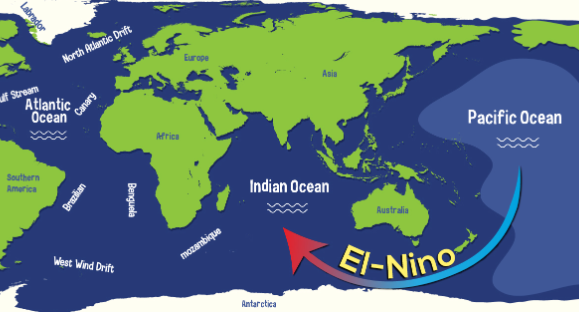2023-24 El Niño – One of the Strongest on Record
El Niño Peaks as One of the Strongest on Record
The World Meteorological Organization (WMO) announced recenlty that the 2023-24 El Niño has peaked as one of the five strongest on record. Despite a weakening trend, the El Niño is expected to continue impacting the global climate in the coming months. The UN agency also predicted above-normal temperatures over almost all land areas between March and May.
Record Temperatures and Extreme Weather Events
The prevailing El Niño conditions have fueled record temperatures and extreme weather events worldwide, with 2023 being the warmest year on record. According to the European Union’s Copernicus Climate Change Service, the global mean temperature breached the 1.5-degree Celsius threshold for an entire year for the first time in January. However, it is essential to note that a permanent breach of the 1.5-degree Celsius limit, as specified in the Paris Agreement, refers to long-term warming over many years.
El Niño Outlook and Potential La Niña Development
In its latest update, the WMO stated that there is about a 60% chance of El Niño persisting during March-May and an 80% likelihood of neutral conditions (neither El Niño nor La Niña) during April to June. There is also a chance of La Niña developing later in the year, but the odds are currently uncertain. Scientists closely tracking the development in India have suggested that if La Niña conditions set in by June-August, it could mean better monsoon rains this year compared to 2023.
El Niño’s Characteristics and Regional Impacts
El Niño is a periodic warming of the ocean surface in the central and eastern tropical Pacific Ocean that occurs every two to seven years on average and typically lasts nine to 12 months. It is associated with increased rainfall in the Horn of Africa and the southern United States, as well as unusually dry and warm conditions in Southeast Asia, Australia, and southern Africa.
Greenhouse Gases and Rising Temperatures
WMO Secretary-General Celeste Saulo emphasized that while El Niño has contributed to record temperatures, heat-trapping greenhouse gases are unequivocally the main reason for rise in temperature. She also expressed concern over the persistently and unusually high sea-surface temperatures in other parts of the globe for the past 10 months, which cannot be explained by El Niño alone.
Importance of Early Warnings and Preparedness
The WMO emphasized that seasonal forecasts are found to be more accurate during El Niño and La Niña events, particularly in the tropics. This highlights the crucial role of early warnings in supporting decision-making and enhancing preparedness and anticipatory action. WMO Secretary-General Celeste Saulo noted that accurate seasonal forecasts from the WMO community have helped countries prepare in advance to try to limit the damage in climate-sensitive sectors like agriculture, water resources, and health, and have saved countless lives.
Month: Current Affairs - March, 2024
Category: Environment Current Affairs








